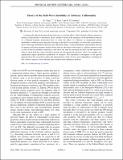| dc.contributor.author | Jorge, R. | |
| dc.contributor.author | Ricci, P. | |
| dc.contributor.author | Gomes Loureiro, Nuno F | |
| dc.date.accessioned | 2018-10-25T14:50:47Z | |
| dc.date.available | 2018-10-25T14:50:47Z | |
| dc.date.issued | 2018-10 | |
| dc.date.submitted | 2018-09 | |
| dc.identifier.issn | 0031-9007 | |
| dc.identifier.issn | 1079-7114 | |
| dc.identifier.uri | http://hdl.handle.net/1721.1/118765 | |
| dc.description.abstract | A numerically efficient framework that takes into account the effect of the Coulomb collision operator at arbitrary collisionalities is introduced. Such a model is based on the expansion of the distribution function on a Hermite-Laguerre polynomial basis to study the effects of collisions on magnetized plasma instabilities at arbitrary mean-free path. Focusing on the drift-wave instability, we show that our framework allows retrieving established collisional and collisionless limits. At the intermediate collisionalities relevant for present and future magnetic nuclear fusion devices, deviations with respect to collision operators used in state-of-the-art turbulence simulation codes show the need for retaining the full Coulomb operator in order to obtain both the correct instability growth rate and eigenmode spectrum, which, for example, may significantly impact quantitative predictions of transport. The exponential convergence of the spectral representation that we propose makes the representation of the velocity space dependence, including the full collision operator, more efficient than standard finite difference methods. | en_US |
| dc.publisher | American Physical Society | en_US |
| dc.relation.isversionof | http://dx.doi.org/10.1103/PhysRevLett.121.165001 | en_US |
| dc.rights | Article is made available in accordance with the publisher's policy and may be subject to US copyright law. Please refer to the publisher's site for terms of use. | en_US |
| dc.source | American Physical Society | en_US |
| dc.title | Theory of the Drift-Wave Instability at Arbitrary Collisionality | en_US |
| dc.type | Article | en_US |
| dc.identifier.citation | Jorge, R., et al. “Theory of the Drift-Wave Instability at Arbitrary Collisionality.” Physical Review Letters, vol. 121, no. 16, Oct. 2018. © 2018 American Physical Society | en_US |
| dc.contributor.department | Massachusetts Institute of Technology. Laboratory for Nuclear Science | en_US |
| dc.contributor.department | Massachusetts Institute of Technology. Plasma Science and Fusion Center | en_US |
| dc.contributor.mitauthor | Gomes Loureiro, Nuno F | |
| dc.relation.journal | Physical Review Letters | en_US |
| dc.eprint.version | Final published version | en_US |
| dc.type.uri | http://purl.org/eprint/type/JournalArticle | en_US |
| eprint.status | http://purl.org/eprint/status/PeerReviewed | en_US |
| dc.date.updated | 2018-10-19T18:01:18Z | |
| dc.language.rfc3066 | en | |
| dc.rights.holder | American Physical Society | |
| dspace.orderedauthors | Jorge, R.; Ricci, P.; Loureiro, N. F. | en_US |
| dspace.embargo.terms | N | en_US |
| dc.identifier.orcid | https://orcid.org/0000-0001-9755-6563 | |
| mit.license | PUBLISHER_POLICY | en_US |
